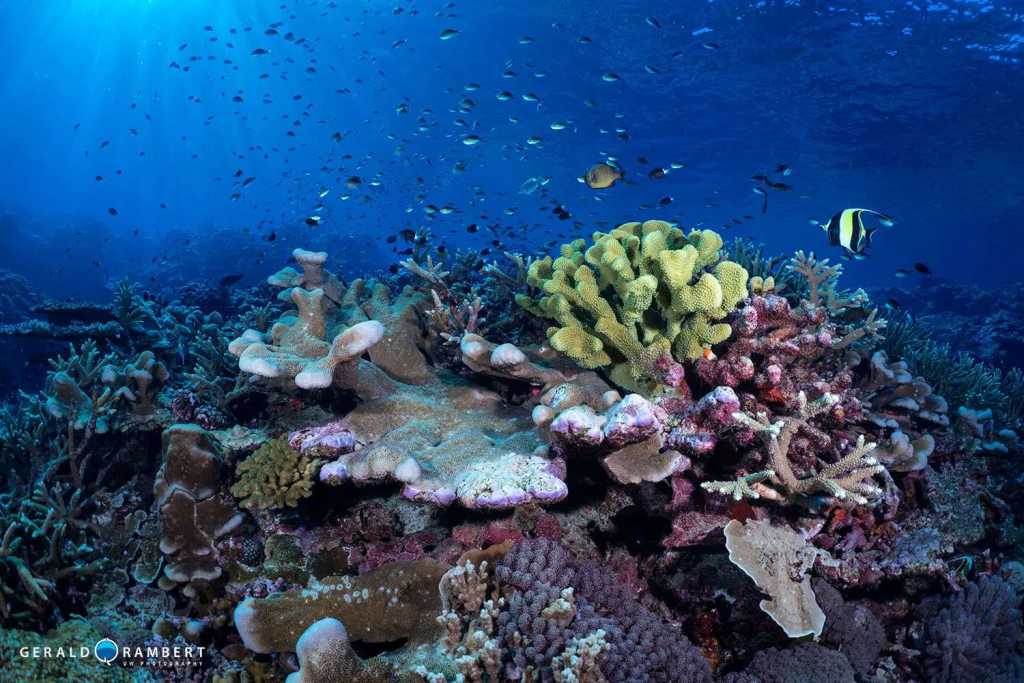
Being an archipelagic country, the Philippines offers great diving opportunities. And if you are looking for a world-class diving and eco-tourism adventure in the country, the Tubbataha Reef is an excellent destination to add to your bucket list. This UNESCO World Heritage Site, situated in the heart of the Sulu Sea, offers stunning underwater views and rich marine biodiversity.
Read on to learn more about the Tubbataha Reef in the Philippines.
Tubbataha Reefs National Park
The Tubbataha Reefs Natural Park, simply known as Tubbataha Reef, is a protected marine area that covers almost a hundred hectares of vibrant coral ecosystems. Located southeast of Palawan and east of the Negros Island, it is home to hundreds of species of fish and corals, as well as a variety of sharks, turtles, and seabirds. The reef’s isolation has helped preserve its extraordinary biodiversity, making it a living laboratory for conservation efforts and marine research.
Accessible only by liveaboard during its short diving season from March to June, Tubbataha offers a rare opportunity to explore pristine waters away from the mainland, with multi-day trips that will immerse you in one of the world’s most spectacular underwater environments.
Diving in Tubbataha
Diving in Tubbataha offers a unique and unforgettable experience- a dream come true for many. The reef boasts some of the world’s best dive sites, such as the North Atoll, South Atoll, and Jessie Beazley Reef.
You can expect to see large schools of fish, manta rays, whale sharks, turtles, and sometimes hammerhead sharks. You will find coral walls covered with a mix of soft and hard corals, providing shelter for many small marine creatures. These walls drop steeply, offering interesting vertical dives. Visibility is usually excellent, making it easy to enjoy the colors and movement of the reef life around you.
Below is a summary of what you can expect to see and experience in Tubbataha:
North Atoll
Northern tip:
- Washing Machine: Strong currents, diverse shark sightings (whitetips, blacktips, grey reef).
- Shark Airport: Massive cleaning station with grey reef, whitetip, silky, guitar, and whale sharks. Rays and turtles also frequent the area.
Southern-southeastern tip:
- Malayan Wreck, Wall Street, Amos Rock: Regular sightings of hammerheads, grey reef, and whitetip sharks. Rich pelagic life includes trevally, tuna, barracuda, manta rays, and turtles. Amos Rock features vibrant coral and benthic life, like crinoids and nudibranchs.
South-southeast:
- Unique reef species like pygmy seahorses, African pompanos, and leaf scorpionfish. Larger reef fish (snapper, grouper, wrasse) appear in strong currents. Near-surface sightings include mantas, eagle rays, and turtles.
South Atoll
Northern tip (Ko-ok):
- Hammerhead schools, pristine coral plateaus, circling jacks, and iconic pelagics like sharks and manta rays.
Southern tip (Delsan wreck):
- Cleaning station for reef fish and sharks, with occasional tiger shark appearances.
Jessie Beazley Reef (Northwest of Tubbataha)
- Known for hammerheads, grey reef, silky, and whale sharks. Features stunning Acropora coral formations. Strong currents bring in abundant marine life—follow your guide closely.
Diver requirements
Due to its remote location and sometimes challenging currents, divers are generally required to have an Advanced Open Water certification and some prior liveaboard experience. If you are a beginner, you may find the environment demanding, so it’s best suited for those with a bit more experience. Diving in Tubbataha is also only possible during the short season from mid-March to mid-June, when conditions are calmest.
The liveaboard experience
All dives in Tubbataha Reefs are conducted via liveaboard vessels, such as the M/Y Gypsy, offering multi-day expeditions to explore this underwater paradise. These trips are fully equipped to provide accommodations, meals, and support for divers throughout the journey. You can learn more about the Tubbataha liveaboard experience here.
Conservation and safety guidelines
To protect the reefs, strict regulations are in place. Be sure to dive with reputable operators and follow all guidelines, including no-touch policies, proper buoyancy control, and respectful interaction with wildlife. These measures help preserve Tubbataha Reef for generations to come.
How to get to Tubbataha Reef
Getting to Tubbataha Reef requires some planning, but the journey is well worth it. The gateway to the reef is mainly Puerto Princesa City in Palawan, which is accessible by direct flights from Manila and other major cities in the Philippines. From Puerto Princesa, liveaboard boats transport divers to the reef on trips that can last from four to seven days. There are also liveaboard trips that travel from Cebu or Negros to Tubbataha. Be sure to book in advance, as trips are limited and fill up quickly.
Practical Travel Tips
Permits are required to visit Tubbataha Reefs, but these are usually arranged by your liveaboard provider. The best (and only time) to visit is during the dive season from March to June. Pack light, but don’t forget essentials such as reef-safe sunscreen, motion sickness medication, and personal dive gear if you have it. Note that there are no facilities on the reef itself, so be sure to bring everything you need with you on the boat.
Takeaway
Tubbataha Reef stands as a testament to the beauty and vibrancy of the Philippine seas. Its spectacular diving, remarkable biodiversity, and status as a conservation icon make it a must-visit for any ocean enthusiast. With responsible travel and a sense of adventure, your trip to Tubbataha Reef in the Philippines will be an unforgettable journey into one of the world’s last true marine wildernesses.



